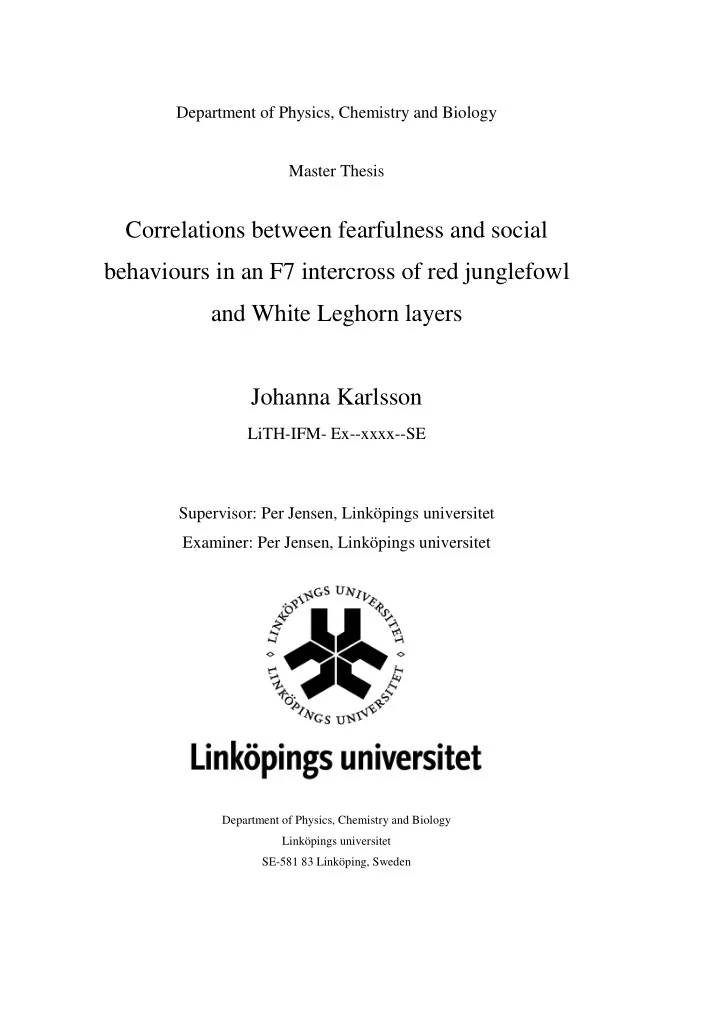

Department of Physics, Chemistry and Biology Master Thesis Correlations between fearfulness and social behaviours in an F7 intercross of red junglefowl and White Leghorn layers Johanna Karlsson LiTH-IFM- Ex--xxxx--SE Supervisor: Per Jensen, Linköpings universitet Examiner: Per Jensen, Linköpings universitet Department of Physics, Chemistry and Biology Linköpings universitet SE-581 83 Linköping, Sweden
Content 1 Abstract…………………………….………………........................ 1 2 List of abbreviations …………………………………………… 1 3 Intro duction………………………………..……………………… 1 4 Material and Methods………………….……….………………… 4 4.1 Animals ……………………………………… ..................... 4 4.2 Behavioural tests..... ……………………….……………… 4 4.2.1 TI ……………………………... ............................... 4 4.2.2 Fear of humans.................................................. …... 5 4.2.3 Aggressivenes s, mirror test......…………………... 5 4.2.4 Open field................................................................ 6 4.2.5 Social test................................................................. 6 4.5 Dat a analysis……………………………………………….. 7 4.6 S tatistics……………………………………………………. 7 5 Res ults……………………………………………………………... 7 5.1. Results from the PCA.......................................................... 7 5.2 Correlations in behavioural responses …………………… ... 8 5.1.1 Correlations among all tested animals...................... 8 5.1.2 Correlations between females................................... 9 5.1.3 Correlations between males...................................... 10 5.2 Differences between males and females in their behavioural response......................................... …………. 11 5.3 Weight and behaviour …………………………………….. 12 6 Disc ussion…………………………………………………………. 13 6.1 Correlations ....... ………………………………………….. 13 6.2 Differences between males and females.... ……………… 15 6.3 Weight and behaviour.... …………………………………. 16 6.4 Conclusion............................................................................... 17 7 Acknowled gements……………………………………………….. 17 8 References…………………………………………………………. 17
1 Abstract The aim of this thesis was to study chickens of an F7 intercross between red jungle fowl and White leghorn layers in five behavioural tests to see if there are any correlations between traits in the intercross. 80 animals were used (40 males, 40 females); they were tested in a TI test, an open field, a fear of human test, an aggression test and lastly a sociality test. The results indicate a couple of correlations between the different variables; chickens with a long TI duration seemed to be less aggressive, and chickens with a high fear of humans seemed to be more social towards other chickens, which could suggest a correlation between fear and social behaviour/aggression. We also found support for previous studies showing that one QTL control chickens behaviour in the TI test based on the strong correlations we found between the variables in the TI test. We could also see differences between the genders in which variables that correlated with each other; this could lead to a speculative suggestion that those behaviours are controlled by genes on the X-chromosome. There was also a significant relationship between the weight of the male chickens’ and their behaviour in the open field test and in the fear of human test, where the heavier males were less fearful than the lighter ones. Keywords: Aggression, correlations, fearfulness, intercross, leghorn layers, red junglefowl, sociality, weight. 2 List of abbreviations WL – White Leghorn layers Agg - Aggression JF – Red junglefowl TI – Tonic Immobility PCA – Principal component analysis ST – Social test OF – Open Field FOH – Fear of Human QTL – Quantitative trait loci 3 Introduction There are three different processes that affect animals during domestication (Schütz et al., 2001); 1) relaxed natural selection, 2) intentional selection for desired traits and 3) correlated selection caused by unintentional selection for traits correlated with traits that are selected for. It is through these processes domestication affects different traits, physiological as well as behavioural, e.g. social behaviours and fearfulness. Selection in modern hens for egg production has been on feed conversion efficiency, i.e. the hens have been selected based on their egg production. One area of research is to look into how this selection has affected other traits and which the genetic mechanisms behind it are. This thesis work is part of a larger research project concerning exactly that; the mechanisms behind domestication and its effect upon other traits. One of the more famous experiments done on domestication was on silver foxes (Trut, 1999). The foxes were selected based only on their tameness, and the results were groundbreaking. The selected foxes differed markedly both in physiology and behaviour from their wild ancestors; e.g. the development of the domesticated foxes fear response was delayed, their coat colour was different (piebald), their ears were floppy and their tails became rolled. In later generations (15-20 generations) shorter tails and legs in the selected foxes started to appear. All of these characteristics are traits seen in domesticated animals all over the world. The process of domestication is one example of correlated selection; when you select for one thing and end up with different changes not selected for. Two genetic mechanisms can be 1
Recommend
More recommend